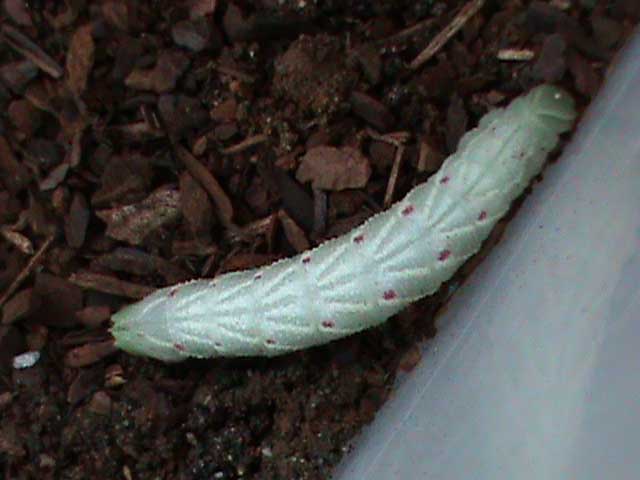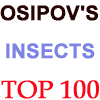|
|
Created/dedicated as per personal communication with Candice Keller, September 8, 2011
Updated as per James P. Tuttle's The Hawk Moths of North America, September 8, 2011
Updated as per BAMONA website, September 8, 2011
|
Klickitat County, Washington
Sphingidae Larvae

Paonias excaecata or myops??, White Salmon, Klickitat County, Washington,
September 6-7, 2011, courtesy of Candice Keller,
note white parasitoid egg on head.
This page is inspired by and dedicated to Candice Keller who sends the image of a Paonias species larva that had been eating plum foliage.
It is either Paonias excaecata or Paonias myops. Both would likely be in her area and both show varying amounts of red spottting, although the most
common forms are without the spotting. I favour P. excaecata.
Candice writes, "Hi, I was looking up some caterpillars that my husband and I just pulled off of my red flowering plum tree (they were munching away) and was trying
to identify them. They look like the lime hawk moths to me -- not for sure though. They are lime green with pinkish red spots, diagonal whitish slashes up their sides
and they have a pointy tail. They seem to be about as long as my little pinky, but when stretched out, they get closer to my ring or pointer finger. One is
longer than the other and seems to be coated in a dusty white, though it is still the lime green. I have one picture, but I will try to get a better one here in a
bit. They did not like being taken off of the branch they were on and tried (what seemed) to bite at my husband -- kind of funny!
"They are very pretty, but I do not want them eating up my poor plum tree I just planted this last spring.
"We do see hummingbird moths here. They are beautiful, but I think they are actually the White Lined Sphinx moth. I have never been able to capture a picture of
them. They seem to come out just at dusk
and feed on the evening primrose here. They are fast. and do not stay around long, but the markings and colors of the White Lined Sphinx moth seem to be what
we are seeing and not the actual Hummingbird Clearwing moth.
"We live in White Salmon, Washington 98672."
Candice did not send a photo with her original email and I reply, "Hi Candice,
I have not yet made a Klickitat County Spingidae larval checklist, but I suspect same species that fly in King County also fly in your area so here is larval
checklist (pictoral) for King County.
http://www.silkmoths.bizland.com/waKingsphlar.htm
Here is a pictoral checklist for Klickitat County adult Sphingidae.
http://www.silkmoths.bizland.com/waKlickitatsph.htm
I would not expect you to have Lime Hawkmoth in Washington as that is a European species.
Based on plum as a foodplant, you are probably seeing Sphinx drupiferarum larvae.
Candice sends images with her response and this message:
"Thanks, and they do look like the pictures on your links! I just cannot tell which one for sure. I just read your article with the homeschool mom from Texas that
saved the tomato hornworm and read the part about the white spots. one of them has a ton of the white spots and the other has a few. Can I fix them? I did put the
caterpillars into a clear plastic container, but did not know that I needed a lid though, so I will find something better for them in the morning.
My kids love to do these kind of things. We bring in preying mantis egg sacs when we find them and let them hatch. So the children are excited for a moth.
I just hope the spots are not the parasites, and, if they are, what can I do? thank you, candice
i tried to pick the clearest pictures. The picture with just the finger pointing up is my husband's and I put my whole hand in. I tried to include the white spots
in too. I don't know if you can use any of these photos. They sure are pretty. Thank you for your time."
I reply, "Hi Candice,
Both Paonias excaecata and Paonias myops have granulated skin, and your larvae are one of those two species.
The granulated skin is defined by large numbers of slightly raised white bumps which appear in a pattern.
Most often the larvae of myops and excaecata are without the red spots that your larvae are showing, but I reared about seventy of the Paonias excaecata
here this summer and a small percentage also had some red spotting. Myops sometimes also have them, and both species can be found on plum.
"One of the larvae definitely has parasitic eggs on its head and thorax. If the eggs are very fresh and the parasite larvae have not hatched and burrowed into
the caterpillar, you can delicately remove them with a pin or needle, being careful not to puncture the caterpillar. If there is a little dark spot on the
caterpillar’s skin under the egg, you are too late. The parasitic wasps and flies are harmless to humans, but if you are going to try to rear a couple of these
larvae, pick ones without parasite eggs or little black spots where older parasites might have entered.
"Good luck. I wish permission to use images, credited to you, on a Klickitat County page I will create??"
"That is fine to use my photos. Not worried about credit, just glad I got a clear enough shot that you can use. I took about 100 of them.
Thanks for all the information. Now, I will be searching for more. I have seen the moths but not the larvae (caterpillars) so it has been a learning lesson for
me. I am going to check in the a.m. first thing on the parasites but it is probably too late. Poor things. I will ask my husband to scrape one off carefully.
I am not good with any kind of parasites-like ticks. Blah!
"Oh, and I dug up a pupae that was dark brown this last spring in my dad's yard in Trout Lake, WA, and brought it home to hatch for the kids. I don't
remember specifically what it looked like, but I know it had the pinks and browns when it hatched. I dig them up all the time in my yard.
Just never thought to let them hatch."
The pink and brown ones are probably Paonias excaecata, and yes, you probably have seen Hyles lineata adults nectaring in late afternoon
to early evening.
For care of "found larvae/caterpillars" visit Manduca sexta larva, Travis County, central Texas,
August 21, 2008, Trina Woodall.
Only seventeen Sphingidae species are listed for Washington on the BAMONA
website. Not all of the species are reported or anticipated in
Klickitat County (Four are reported on BAMONA as of September 8, 2011).
It is hoped that this checklist, with the thumbnails
and notes, will help you quickly identify the larvae you are likely to
encounter.
A "WO" after the species name indicates that
I have no confirmed reports of this species in your county, but I
(William Oehlke) expect that this moth with its larvae are present or
might be present. I have included many species not on the
BAMONA list for Washington; I believe they are or might be present
A "BAMONA" indicates the
moth is reported in Lepidoptera of North America,
#1. Distribution of Silkmoths (Saturniidae) and Hawkmoths (Sphingidae)
of Eastern North America,
an excellent little booklet available through Paul Opler.
Please help me develop this list with improved, documented accuracy by
sending sightings (species, date, location), preferably with an
electronic image, via email to
Bill Oehlke.
Please also send your sightings to BAMONA, an excellent online resource.
Sphinginae subfamily
Sphingini tribe:
 |
The caterpillars are called Tomato Hornworms and each has a black horn at the end of the abdomen.
Larvae feed on potato, tobacco, tomato, and other plants in the
nightshade family (Solanaceae).
|
 |
Sphinx chersis
WO, the Northern Ash Sphinx or Great Ash
Sphinx:
The larvae are pale bluish green. The head has a pair of yellow
lateral bands meeting at the apex. The oblique, lateral stripes are
pale and bordered anteriorly with a darker green.
Larval hosts are ash, lilac, privet, cherry, and quaking aspen.doubtful
|
 |
Larvae hide in the day and feed primarily on cherry, plum, and apple
at night. Larvae have been found on Amelanchier nantuckensis
in Massachusetts and have been reared to pupation in Michigan on
Prunus serotina. Note purple oblique lines.
|
 |
Sphinx perelegans
WO, the
Elegant Sphinx:
The basic body colour can be either glaucous or apple-green, without the earlier body tubercles. The oblique side stripes are white,
edged with purple.
The horn is sky blue. The spiracles are pale orange and the anal flap is edged with yellow.
|
 |
Sphinx vashti
BAMONA,
the Snowberry Sphinx
Larvae feed on the common snowberry (Symphoricarpos albus)
and on coralberry (S. orbiculatus). Note the two golden
lines of slightly raised bumps, one just behind the head, the other
on the thorax.
|
Smerinthini Tribe:
 |
Larvae feed on cottonwood and poplar (Populus) and willow
(Salix).
Larvae are very chunky with little to distinguish them
from Pachysphinx modesta.
|
 |
Larvae accept willows, birches, and cherries.
I have also found them in the wild on oak in eastern Canada.
Skin is quite granulous.
|
Paonias excaecata, parasitized, feeding on plum, White Salmon, September 7, Candice Keller.
 |
Wild cherry species are the favorites as larval foodplants, but eggs
will also be deposited on birches and other forest trees.
There are varying degrees in the amount of red markings along the sides.
|
 |
Smerinthus ophthalmica
WO:
Ophthalmica larvae resemble cerisyi larvae, both being pale
green, with granular skin, pale lateral diagonal lines, faint red
spiracular circles, and very pale longitudinal lines running from
head to more pronounced anal diagonal line.
Larvae have green heads bounded dorsally with pale yellow
inverted "V". Note blue horn.
|
Macroglossinae subfamily
Dilophonotini tribe:
 |
Larval host plants include Snowberry (Symphoricarpos),
honeysuckle (Lonicera), Coralberry, viburnums, high bush cranberry and hawthorn (Crataegus).
Horn is black with a slightly lighter base. This western species was formerly classified as
H. diffinis or H. senta. Those species west of the Continental Divide are now classified as
H. thetis. Listed as senta on BAMONA
|
Macroglossini tribe:
 |
Hyles gallii
WO, the Bedstraw Hawk Moth
or Gallium Sphinx
This species is not reported in Chippewa, but it has been recorded in
eastern Wisconsin counties. I suspect it is present.
Larvae come in black and in brown forms and often feed on
Epilobium (fireweed).
|
 |
Hyles lineata
WO, the White-lined Sphinx
Larvae are highly varied and feed on a great diversity of plants
including willow weed (Epilobium), four o'clock (Mirabilis),
apple (Malus), evening primrose (Oenothera), elm
(Ulmus), grape (Vitis), tomato (Lycopersicon),
purslane (Portulaca), and Fuschia.
All larvae seem, however, to have the red/black swellings split by
dorso-lateral lines.
|
 |
Larvae feed on elegant fairyfan (Clarkia unguiculata) in the evening primrose family (Onagraceae).
|
 |
Larvae feed on willow weed (Epilobium) and possibly thimbleberry (Rubus parviflorus).
|
|
|
Enjoy some of nature's wonderments, giant silk moth cocoons.
These cocoons are for sale winter and fall. Beautiful Saturniidae moths will emerge the following spring and summer.
Read Actias luna rearing article. Additional online help available.
Use your browser "Back" button to return to the previous page.
This page is brought to you by
Bill Oehlke and the
WLSS. Pages are on space rented from Bizland. If you would like
to become a "Patron of the Sphingidae Site", contact Bill.
Please send sightings/images to Bill. I will do my best to respond to
requests for identification help.
 | 
Show appreciation for this site by clicking on flashing butterfly to the left.
The link will take you to a page with links to many insect sites. |
















